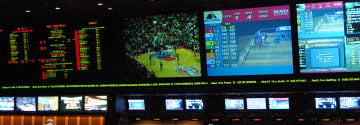NBA Betting Types and Odds
Even though basketball is a simple game, it takes time and effort to gain a high level of knowledge and gain an edge over bookmakers with NBA betting.
This article explains the basic rules of basketball, the types of bets you can use, and give an overview of what you need to consider to make money with NBA betting.
NBA Betting: Understanding the Rules
Basketball is played five against five on a court made up of 2 baskets, under which there is an area called the racket. The games are divided into four quarter-times of 10 minutes (12 minutes in NBA).
A player who scores from inside the racket offers 2 points to his team. If the shot is taken from the outside of the racket, then this is worth 3 points. Free throws, awarded after a foul, are worth 1 point.
To score during an active phase of play, a player must continuously bounce the ball. He is not allowed to take more than two steps without a rebound. This is called a “walk.” This fault also applies if the player jumps and lands on his feet without releasing the ball.
Also, a player does not have the right to resume his dribble after stopping (or to take back the ball after having released it if the latter has not touched anything). It is also forbidden to “carry” the ball: the hand must be in constant contact with the ball’s upper part.
NBA Betting Types and Odds
Money line betting: The NBA betting moneyline is no different from the NFL or baseball betting moneyline. Even if the sport is different, the point is to predict the winner of the game and bet.
Handicap betting: Basketball handicap betting is a slight evolution of moneyline betting. Both teams will be given a positive or negative scoring handicap so that the objectively perceived difference in ability is even.
The team that appears to be superior is given a negative handicap to overcome. The team that seems to be disadvantaged is given a positive handicap treated as a lead from the beginning.
Totals betting: In the NBA betting total market, it doesn’t matter which team wins. It is a betting method that predicts whether the total number of scores of both teams will exceed (over) or fall below (under) the bookmaker’s expected value.
Quarters and halves: In addition to the basic betting market described above, you can also place bets on the first quarter and the first half of NBA games. Your betting NBA betting odds and options (money line, handicap, total) will remain the same, but you will bet on results in shorter spans.
Outright market: There is little room for mistakes in betting on individual matches, and it is not uncommon for randomness and luck to change the outcome. In contrast, the outright market generally allows you to bet on longer spans, such as the NBA’s 82 regular-season games (or more).
How to Bet on NBA Odds
1) Schedule analysis: whether the team is in B2B (when a team played the day before) or not, study the upcoming games to see if the schedule for the team is complicated or not (because in the NBA, the season is long with a lot of matches and sometimes the teams do “no matches”).
2) Study the last matches of the teams and their previous confrontations: Watch the game’s summary. However, H2H is relatively irrelevant in the NBA, with rosters changing every year and different game circumstances. That can “reassure” but in no case condition a bet.
3) Compare the two teams’ collective statistics: attack, defenses, rebounds, passes, stray balls—you can use them but not everything and anything. The emphasis should above all be on the average number of possession per match (basically knowing if a team prefers the half-court game and goes after 24s to build an attack or if it favors fast play).
5) Inventory of the teams: Note the injured and the unsure, and it is often the longest because sometimes a player is announced on the field or in the stands only 30 minutes before the match. Hence, it’s not always easy; it can be the most complicated factor to consider.
6) Use an algorithm that evaluates your analyses in a calculation that allows you to compare the theoretical odds to the odds on the book to see if there is value. Then, select a bet with odds greater than or equal to 1.70.

